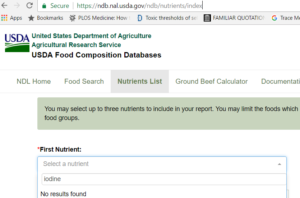Mental health and chronic illness rates in the grade school and high school population of public schools has increased significantly. It is causing a problem for budgeting special needs staff for education and for nursing support for the chronic illness issues.
Read more, one part of a planned series on the topic: https://www.focusforhealth.org/special-ed/
A few thoughts I and others have had on the topic of special needs issues in children and adults:
Illness is a limiting factor affecting too many people in the U.S. and elsewhere. The rate of autism in children has reached 2% of U.S. children and it is a condition that was not present in the medical history of psychiatric care prior to around 1930. (Denial, Blaxill) Malnutrition of several nutrients including iodine seem to be involved based on my reading (post) so the presence of the condition after 1930 may have to due with the Great Depression’s impact on nutrition.
The planet and its nations can’t afford an increasingly ill population. We are not just overweight (or chronically ill) because we eat too much and exercise too little, some do, but why are we eating too much is the better question to ask. A healthy person has a healthy appetite that guides to balanced amount of food without counting calories and a healthy person has a healthy interest in active play or work that exercises the body. Blaming doesn’t solve problems it just denies responsibility and prevents more helpful answers from being discovered. When health statistics change as rapidly as they have in the U.S. and an increasing number of other nations then it is not a question of individual choice but of environmental changes.
Ninety percent of women are hurting on a daily or monthly basis in a way that only three percent were hurting in the 1920s – what changed? Our diet – it contains significantly less iodine and more bromine than it did prior to the 1920s. Fluoride added to the water supply to protect children’s teeth may also be part of the problem and perchlorates from products we commonly use. If too little iodine is present than the body may store bromine, chloride or fluoride in places that iodine would normally be used. The condition is considered benign and not related to breast cancer risk – except for maybe 5-20% of the people with the problem, pubmed/25970956, which if 90% of women have the problem than the math is looking unpleasant for many women.
I used to be one of the 90% but then I took extra iodine and now I’m not one of the 90% – and that is less painful for me physically but I still feel emotional pain at the idea that 90% of women are suffering each month – unnecessarily in my opinion. The treatment was fairly easy with only a few side effects. Taking selenium, 200 mcg per day is also important which is not mentioned in the PubMed link. Iodine deficiency and hypothyroidism are related conditions which also are associated with an increased risk for autism (post) so 90% of women suffering from a condition that appears to be resolved by simply increasing a dose of iodine seems like a simple solution worth pursuing.
“The incidence of fibrocystic breast disease in American women
was 3 percent in the 1920s. Today, 90 percent of women have this
disorder…” Read more: http://www.jpands.org/vol11no4/millerd.pdf
or also in a post on this site: Why did the USDA remove Iodine from its Food Composition Database?
Toxins in the air, water and food supply have increased and nutrient content of many foods that are easily available have decreased. Denying that is denying a chance to improve before more species are also negatively affected. Blaming individual humans for making poor individual choices doesn’t explain why so many species are suffering loss of fertility and large drops in population.
The planet and its nations can’t afford an increasingly ill population. We are not just overweight (or chronically ill) because we eat too much and exercise too little, some do, but why is the better question. A healthy person has a healthy appetite that guides to balanced amount of food without counting calories and a healthy person has a healthy interest in active play or work that exercises the body.
Blaming doesn’t solve problems it just denies responsibility and prevents more helpful answers from being discovered. A book I just picked up recently written by a pediatric endocrinologist is upsetting for me to read because blaming the patient for not following the doctor’s advice is a theme rather than considering the possibility that the advice itself might be wrong or incomplete. In my experience as a pediatric nutrition counselor I observed that children are the best at self-regulating their intake and generally did quite well at eating enough but not too much and generally had a reasonable height/weight ratio- except for the few who seemed to be overweight no matter how much their parent tried to help them achieve a healthy weight for height.
Parents have lost custody or risked losing custody of their children when too large or too small and I’ve written about both issues. Undiagnosed congenital (from birth) hypothyroidism can be a cause of a child being tiny, too slim seeming except their bone structure is also slim so proportionally they tiny child can look healthy for their tiny weight. Force feeding wouldn’t help that child. Other children can be overweight even on limited calories, possibly due to an undiagnosed hypothyroid problem that occurred later than birth. Putting either the tiny child or the overweight child in foster homes would not solve an undiagnosed endocrinology problem. (post about the overweight child, Foster Care case) (post regarding tiny child and Foster Care case)
Holding parents accountable for something that is neglect or abuse is important but blaming them for underlying health problems that aren’t being diagnosed in many many people is wrong and there is no reason to expect that a Foster Care family would be able to make the child gain or lose weight if the underlying reason is an actual health problem.
To continue, after having finished the book, there is some value in it but there are also errors and opinion presented as fact. A dangerous idea is presented, likely meant as a joke but there is no qualifier given that it was a joke and not meant as advice and that the idea shouldn’t be followed. (p125 includes a maybe slip a mood altering substance in someone’s drink idea – no don’t do that ever, even if it is a legal substance and meant to boost the mood, it is illegal. https://law.stackexchange.com/questions/6158/is-it-an-offence-to-spike-someones-drink
References ideally should be included for all information presented as facts in a book with educational goals. The section on nutrition is simplified to the point of dangerous misinformation and sugar is stressed as the primary problem with our processed food diet. It is a problem but not the only one.
Drinking any calorie containing beverage as a thirst quencher is a problem that I observed and counseled parents about for helping children who were heading upward on the weight to height ratio. Within three months usually, when the next appointment would be typically scheduled, the parents often had such success that they had forgotten that there had been a concern. Children are good at regulating food intake however the intake of liquids is not regulated in the same way as solid food. Our brains expect water for thirst because that is what nature provides. Once a baby is weaned from mother’s milk there is not typically any other calorie beverage in the natural world. As cavemen and women we did not milk wild animals or squeeze juice from fruits. We ate the fruits and wild animals as whole foods which are recognized by the brain as filling due to fiber or fats. Carbohydrates alone do not have the appetite satisfying effect on the brain that fiber and fats provide.
Regarding pediatric or adult endocrinology and the increase in metabolic syndrome and Type 2 Diabetes – sugar can increase insulin resistance but so can an absence of magnesium. Sugary processed foods often are not only deficient in fiber but they are also deficient in magnesium and B vitamins which are needed to process the sugar into usable energy.
More about magnesium deficiency and insulin resistance is available here: Association of Serum Magnesium Deficiency with Insulin Resistance in Type 2 Diabetes Mellitus, (G3.122)
And I discuss it in more detail on a different website: https://effectiveselfcare.info/2017/10/15/if-magnesium-deficiency-is-cause-of-a-diabetic-pain-why-give-opioids/
Magnesium deficiency may also be an underlying problem with migraine headaches and other chronic pain and muscle spasm type conditions. Calcium causes muscle contraction and magnesium allows the muscles to relax again.
To repeat an important point: When health statistics change as rapidly as they have in the U.S. and an increasing number of other nations then it is not a question of individual choice but of environmental changes.
Toxins in the air, water and food supply have increased and nutrient content of many foods that are easily available have decreased. Denying that is denying a chance to improve before more species are also negatively affected. Blaming individual humans for making poor individual choices doesn’t explain why so many species are also suffering loss of fertility and large drops in population.
Evidence based medicine is helpful as guidance but it is just a starting point for individualizing care further for each patient’s needs and if it is based on inaccurate or incomplete research then it may provide inaccurate guidance, but it is a starting point at least.
Disclaimer: Opinions are my own and the information is provided for educational purposes within the guidelines of fair use. While I am a Registered Dietitian this information is not intended to provide individual health guidance. Please see a health professional for individual health care purposes.



